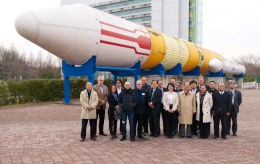Latest News
Event Report: Visit to JAXA's Tsukuba Space Center

On March 16, eighteen NCCJ members and their friends boarded the Tsukuba Express at Akihabara to visit the JAXA (Japan Aerospace Exploration Agency ) Space Center at Tsukuba.
A JAXA bus met us at the station, and transported us to the JAXA campus in the new “technotown” of Tsukuba. We were presented with “VIP visitor” labels while on the bus, and on arrival, we were welcomed by Mr. Mitsuru Watando, the Deputy Center Director, who explained the basic missions of the facility, where about 750 people are employed to lead Japan’s activities in space.
The Center is responsible for supervising and guiding the development of the rocket launch vehicles and other space vehicles, as well as developing and operating earth satellites, including earth observation satellites to monitor the environment (including greenhouse gas emissions), the weather, and to assist communications and navigation in addition to disaster prevention and recovery. The facility also has the task of supporting Japanese astronauts and experiments aboard Kibō, the Japanesese Experiment Module.
Following this introduction, we were provided with an explanation of one of the experiments carried out aboard Kibō, where protein crystals are grown in special experimental equipment units using the microgravity (one millionth that of earth) environment of the ISS (International Space Station). Thanks to the absence of convection and other gravity-related phenomena, such crystals achieve a purity of form that cannot be achieved elsewhere, making them especially suitable for analysis. The analysis of these folded protein structures allows the development of drugs and pharmaceutical products which may find uses in a variety of fields, including the treatment of muscular dystrophy, and the development of a universal anti-influenza drug.
We then proceeded by bus to the building housing the Kibō Mission Control room – a smaller version of NASA’s Houston Mission Control room, and linked by video to Houston. At the time of our visit, there were no Japanese astronauts aboard the ISS, and the astronauts were asleep, so there was little action. Typically, the Mission Control is led by a JAXA employee, the Flight Director, supervising external contractors who are taking care of the onboard experiments. Even when there are no Japanese astronauts on the ISS, the Tsukuba Mission Control is manned on a 24/7 basis, in three shifts. In answer to a question, it was explained that backup facilities were in Houston – the 2011 quake having effectively knocked out operations for about a week, and during this time, Houston provided cover for Tsukuba.
The bus then transported us to the astronaut training facility. We were told that JAXA’s first call for astronauts produced a response of many thousand times the required number, and those who went through the first “paper” screening passed through a variety of tests. We were shown (but not permitted to enter) the isolation chamber where would-be astronauts were confined without contact with the outside world for up to a week at a time. As well as the testing and training facilities, we viewed a variety of astronaut paraphernalia, including bags of freeze-dried Japanese food such as ramen, rice balls, and the like, and some of us were amused to see that Japanese tabi (split-toed socks) had made their way to space, as worn by the Japanese astronauts.
On to the Space Dome, containing models of Japanese satellites and space vehicles, as well as a full-size replica of Kibō. One thing that amazed many of us was the sheer size of some of these satellites. The unmanned ISS supply module, Kōnotori (white stork), also referred to as the H-II Transfer Vehicle (HTV), carries a total of a hefty 6 tonnes of cargo, in pressurised and unpressurised containers, and is almost 10m in length and 4.5m in diameter – the size of a truck trailer. Other satellites were appeared to be the size of small houses, giving the lie to the idea that all satellites are small trashcan-sized devices. The interior of the Kibō replica was surprisingly roomy – about the size of a large bus – even though used only for the Japanese scientific experiments and not for living, just this pressurised module seemed roomy enough to live in. It was explained to us how colour-coded rails and strips along the floor helped the astronauts to distinguish “down” from “up” in a near-weightless environment.
Cutaways of complex hydrogen and liquid oxygen rocket engines helped us understand where the term “rocket scientist” originated – the problems of containing and regulating such volatile and potentially explosive fuels have to be solved by extreme engineering solutions. For example, the honeycomb bracing in the aluminium fuel tanks is machined from solid metal, to avoid the microscopic leaks that might occur through welding.
A 50m long H-II booster stands as a “gate guard” to the Center, and we moved there for a group photo before proceeding to the gift shop, where a wide variety of goods was on sale, including astronaut teddy bears, “space curry” (“not very filling,” one person remarked), and other such space-related souvenirs.
The JAXA bus then returned us to Tsukuba station, and the express back to Tokyo. We came away with an enhanced appreciation of the Japanese space program, and gratitude to the JAXA staff who did an excellent job of explaining, in excellent English, the achievements and the future goals of the organisation.